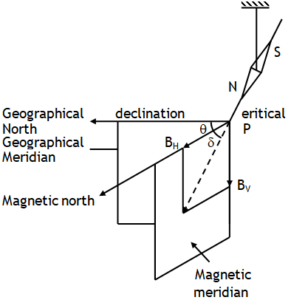^Dip (δ) & Horizontal component
^Dip (δ) & Horizontal component
The vertical component of the Earth’s magnetic field points downwards in the northern hemisphere. If the magnetic needle of a dip circle is perfectly balanced about a horizontal axis so that it dips (moves down) in a vertical plane of the magnetic meridian and aligns. Itself at some angle to horizontal at which ![]() are parallel, this angle is known as the angle of dip (also known as inclination).
are parallel, this angle is known as the angle of dip (also known as inclination).

We can say that angle of dip at a place in the magnetic meridian is the angle between horizontal component of earth’s magnetic field (H) & its resultant intensity (B) or it is the angle made by the axis of a freely suspended magnet with the horizontal line. e.g. Dip angle = 420 at Delhi.
In figure shown, the resultant magnetic field is in the magnetic meridian, d is angle of dip, BH and BV denote horizontal and vertical components of Earth’s magnetic field respectively.
BH = B cosδ, BV = Bsinδ
![]()
Exactly at the equator the Earth’s magnetic field is parallel to the Earth’s surface, angle of dip & vertical component of Earth’s magnetic field are zero, thus a freely suspended magnet will be horizontal at the equator. Exactly at the centre of poles the Earth’s magnetic field is normal to the surface of the Earth, angle of dip is 900 and the horizontal component of the Earth’s magnetic field is zero. Therefore a freely suspended magnet will become vertical at the poles.

